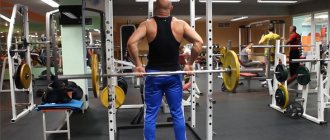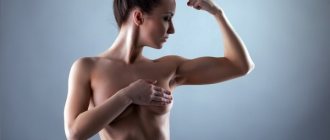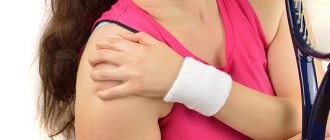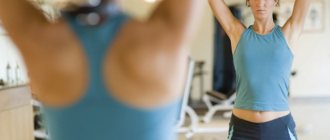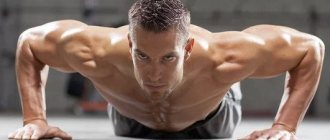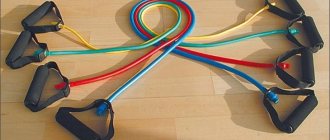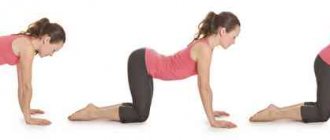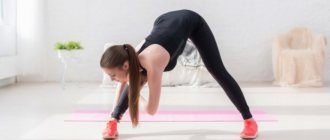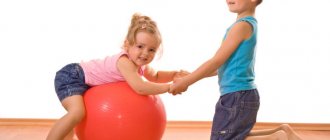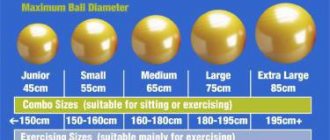After surgery for an intervertebral hernia in the cervical spine, I became a group 1 disabled person for life. Both legs and my right arm completely stopped working, my back and abdominal muscles practically didn’t work, problems began with the pelvic organs, bedsores appeared, etc. It seemed that a bell from another world had already rung for me. Realizing the severity of my condition, I began, with titanic persistence, to practically recreate myself.
A patient with any level of spinal damage will be rehabilitated faster if he begins to engage in physical therapy as early as possible. At the same time, the restorative effect directly depends on his conscious participation in treatment, on his willingness to work, gradually moving from easy exercises to more complex ones.
First of all, it is necessary to develop the muscles of the arms: restoring their functions will allow the patient to feel more or less independent from others, which is of great importance. At the first stage, I, lying on my back, revived the muscles of the hands, wrists and forearm with special exercises, developed mobility of the spine in the cervical region, strengthened the neck muscles, and then did exercises for all these muscle groups using a pulley system and dumbbells. I performed the exercises three times a day, the number of approaches was 3-6; in each exercise, with one approach, I did no more than 12 special movements. Two years later, when my hands came back to life, I increased the number of movements.
This complex will be useful for those patients with damage to the cervical spine who have at least partially preserved the conductivity of spinal cord impulses. But I want to warn you: when performing the complex, you must follow the rules of self-control.
1. Exercises for fingers and wrists
1. Join the four fingers of both hands in a lock in front of the chest. The thumbs, pressed with the tips to each other, turn and rotate in both directions. 2. In the same position, rotate your thumbs relative to each other. 3. Unclench your fingers and forcefully clench them into a fist. 4. Fan out your fingers and connect them again. 5. Join your fingers in a lock in front of your chest. Turn the hands in both directions and rotate them relative to the wrist. 6. From the same position, raise and lower the hand and rotate it relative to the wrist. 7. Join your palms. Squeeze them forcefully and rotate them in both directions relative to the wrist. 8. Interlace two fingers at a time and pull them in opposite directions. 9. Take one brush with another. Turn and rotate the 2nd free hand in both directions. 10. Hold a nut (or a small hard ball) between your palms. Make circular movements with your palms, squeezing the nut with effort. 11. Place a foam pad on your palm. Bend your fingers, squeezing it (after the bending force appears in the fingers, the pad is replaced with an expander). 12. Pick up a rubber bat. Slowly turn your hands in opposite directions (palms should not slide over the surface of the bat). 13. Clamp one end of the bit. Use your hand to tilt the free end of the bat in both directions. 14. Touch the rosary with your fingers (you can string an ordinary wooden abacus on a string). 15. Hold two nuts in one palm. Rotate them with your fingers. 16. Connect four fingers in front of the chest in a lock with palms facing out. Stretch your arms forward. 17. Weave and unravel the ends of three ropes with a diameter of 6-8 mm. 18. Press your palm firmly against the surface. Clench your fingers into a fist and straighten them.
2. Exercises for the neck, arms and shoulder girdle
1. Pressing your palm on your forehead, resist it with an oncoming movement of your head. 2. Pressing your palm on your head in the temple area, resist it. 3. Lower your head down, trying to press it to your chest if possible. 4. Place your palms with edges under your chin. Tilt your head, overcoming the resistance of your palms, while simultaneously turning them to a horizontal position. 5. Raise both shoulders simultaneously with the maximum possible amplitude (MVA), hold them in this position for 2 seconds 6. Raise each shoulder alternately with MVA, holding it in this position for 2 seconds. 7. Abduct and abduct the shoulders with MBA. 8. Rotate your shoulders in both directions with MBA. 9. Connect your fingers in front of your chest into a lock. Lower and raise elbows with MBA. 10. Bring your palms and elbows together in front of your chest. Rotate your forearms with MBA. 11. Connect the hands at the back of the head into a lock. Bring your elbows in and out, and then rotate them in both directions with an MBA. 12. Bend your elbows and place your hands on your shoulders. Rotate elbows with MBA. 13. Take in your hands the ends of the rope thrown over the pulley. Raise one arm - the other falls under its own weight. 14. Take in your hands a bracket sliding along the pipe; a weight is attached to the rope on the side of the legs. Move the bracket along the pipe. 15. Take in your hands a bracket that slides along the pipe; a load is attached to the rope on the side of the head. Move the bracket along the pipe. 16. Place your hands in front of your chest into the loop through which the Balkan frame pipe is passed. Lift your torso off the bed. 17. Use brushes to cover the pipe of the Balkan frame. Move your hands back and forth along the pipe. 18. Take the ends of the bat in your hands. Bring your arms in and out, overcoming the elasticity of the rubber bat. 19. Use one hand (and then two hands) to hold a load suspended on a rope. Swing the load sideways with the MBA. 20. Push up the barbell. 21. Climb the steps of the rope ladder with your hands, lifting your torso to the maximum possible angle of elevation. 22. Grasp the back of the bed with your hands. Pull yourself up with your arms. 23. With one hand (and then with both hands), take the end of the rope, the other end of which is tied to the frame. Rotate the free end of the rope with the MBA.
3. Exercises for the arms and shoulder girdle with a block system
For a year and a half, I fanatically performed all possible exercises with my hands while lying in bed. Gradually, my fingers began to move, my hands began to clench more tightly, the pain in my wrist from compressive and tensile loads disappeared, my right hand came to life, and my left one became stronger. The question arose about further strengthening the muscles. A block system or rubber expanders are excellent for this purpose. The pulley system is preferable to resistance bands because it makes it easier to control the load. Exercises with the pulley system can be performed while sitting in a stroller or lying in bed. The size of the load suspended on the rope of the pulley system should be no more than 3 kg. But one important feature must be taken into account: the more time has passed since the spinal injury, the more caution should be exercised when moving on to weight-bearing exercises. It is unacceptable for spinal specialists to work with a load through force, overcoming pain. Due to the imbalance of movements of different muscle groups, spasticity and cramps can occur in any part of the body, which can even lead to joint dislocations. Therefore, exercises at the initial stage should be performed without weights, creating conditions for “complete weightlessness” for the hands.
Exercises for disabled people with spinal problems
- Warm up and stretch the neck muscles. Sitting in a stroller, we turn our heads left and right 10 times. The movements are very smooth without jerking. Next, we tilt our heads - we aim for the shoulder 10 times, back and forth 10 times. We finish with semicircular movements, 5 in each direction (if you feel dizzy, reduce the number of movements or leave them altogether).
- Now let's focus on the hands. Rotate your hands, then rotate your forearms, ending with your whole arm. You can add shoulder rotations when your arms are down.
- We intertwine our fingers, turn the interlace inside out and reach for the ceiling with our hands turned out.
- Sitting in the stroller, we lie down so that our chest is on our knees. At this time, we clasp our hands behind our backs and raise them as high as possible - 5-6 times.
- Bend exercises from the “sitting” position to the “chest on the knees, hands behind the back” position. With each bend, we stretch our upper body forward, then you can linger in this state for a few seconds.
- We sit straight. The bent arm is placed behind the back of the head and lowered along the back, aiming as low as possible. Each hand up to 8 times.
- A similar exercise - while sitting in a stroller, raise your bent arm from below your back as high as possible. Also up to 8 times. With enough practice, you can clasp your hands.
- Exercises for stretching the muscles of the upper back - bending . The shoulders are lowered in turn, the fingers of the hand whose shoulder is lowered are on the axis of the wheel. At the same time, we tilt our heads in the opposite direction, as if we want to turn the stroller on its side.
- Exercise with light weight - you need dumbbells of about 2 kg. Take dumbbells and lower them between your legs so that your thumbs point to the floor. Next, we spread our arms diagonally to the sides and raise the dumbbells to shoulder level.
Next, we will consider 3 exercises that are recommended to be performed after warming up (you can use the warm up written above - exercises 1-8). For each exercise, you choose three approaches. Repeat the exercise every 10 times without stopping, and then rest for 30 seconds to 1 minute. Repeat 10 more times, rest again and repeat a third time. In most cases, try to leave 48 hours between workouts to give your muscles and joints complete rest. Stressed tissues take time to recover!
Observation diary
Reason won. My experience in science helped me analyze the specifics of the processes occurring in the human body. I thoroughly understood the intricacies of known rehabilitation techniques and chose only what is applicable to spinal necks. The observation diary that I carefully kept helped a lot. As a result, I was able to develop a new practical method of self-control. It allowed me to monitor the dynamics of changes in well-being, taught me to listen to my body, understand it, analyze the causes of ailments and detect the slightest improvements.
Self-control has made my life much easier. The optimal form of diary for me was filling out tables and drawing graphs every day.
In the table I enter the information that seems essential to me: I record with a cross in the appropriate columns the exercises that I performed (standing, sitting, on all fours, for arms, for legs, etc.), medications and medical procedures.
Seated tricep dips
This exercise will strengthen your triceps, chest, and the front of your shoulders. Strengthening these parts of the human body will be especially useful if it is possible to part with a wheelchair.
The exercise is suitable for people with disabilities who have upper body strength.
While sitting, place your hands on the armrests of your wheelchair or other chair. Make sure they are directly under your shoulders. Raise yourself up until your arms are fully extended, and then slowly lower yourself down until you are seated again.
Modification
If you lack arm strength but have strength in your legs, you can use them to help you out a little. But try to let your hands do as much of the work as possible. Start with a small number of repetitions (maybe even 1-2), gradually the muscles will get stronger and you can increase the number of repetitions.
https://youtu.be/-N5kFGwgwlA
Additional physical education classes for older people
Old age is characterized by significant changes in the body, such as the appearance of chronic diseases, a slowdown in metabolism, disturbances in the functioning of the respiratory, digestive, cardiac and endocrine systems, and diseases of the musculoskeletal system. Physical therapy for older people will help:
- Reducing the threat of heart and vascular diseases.
- Increasing endurance and adapting the body to moderate daily exercise.
- Improving the quality of sleep and appetite, which pensioners often have problems with.
- Getting rid of excess weight, which will cause suffocation of well-being and increase a person’s physical capabilities.
When doing physical exercises with older people, not only their external changes for the better are noticeable, but also the emergence of self-confidence and in their abilities, as well as the normalization of the mental state of the elderly.
https://www.youtube.com/watch?v=ytpressru
It is optimal to conduct the first physical therapy sessions under the supervision of an experienced trainer, who will determine the required load and select the most effective set of exercises for an elderly person, taking into account his diagnosis and general condition. For older people, there are no restrictions on cardio or strength training.
To practice physical therapy for the elderly, a comfortable and convenient environment is necessary, as well as the presence of a special sports brand and shoes. To carry out exercise therapy, you do not need to resort to the use of special sports equipment, but devices such as expanders, balls, gymnastic sticks, etc. They greatly simplify classes and give them variety.
You can add various exercises to the standard set of physical therapy exercises for older people, which are usually performed during exercise. When performing therapeutic exercises for the elderly, you can use head tilts, shallow squats, push-ups from furniture or walls, and much more. When using push-ups, special vigilance is required, since for each person this exercise can be more or less difficult.
Taking a lying position, an elderly person can perform bending legs to the stomach, bending the knees in different directions, slowly raising the legs at an angle of 90 degrees, “Bicycle” and “scissors” with the legs. Each of these exercises has a positive effect on the old man’s body.
It is possible to achieve good results with the help of therapeutic exercises only if the set of exercises is selected correctly by an experienced trainer, is safe for an elderly person and effective for a given physical condition. You need to start doing physical activity gradually, starting with the simplest exercises and a small number of repetitions.
An elderly person can and should do therapeutic exercises at any age and in any mood. A simple set of physical activities will significantly improve the mood and give confidence to the old man, which will become an incentive for him to new achievements.
Back to Medical Care Section
Knee rises
This is a great way to strengthen your hip flexors—the muscles around your hip that help your hip move—and therefore make it easier to carry, walk, and bend.
The exercise is suitable for disabled people with some control of the lower body.
While sitting, lift one knee up until your foot is a few inches off the ground. Lower slowly and repeat as well. Once you've completed the reps on one leg, repeat on the other.
Modification
If you are struggling to get your foot completely off the floor, you can use your calf muscle to flex your ankle, which will aid the movement. Be careful not to let your calves do all the work.
Exercises with a partner
Now let's look at exercises for which you will need a second person.
- Take a position - lying on your back. The task of the assistant or nurse is to stand at the patient’s head and place his palms on the patient’s forehead. The patient's task is to push the patient's palms away with his forehead. The assistant should resist as the patient tries to push his hands away with his forehead.
- Take a position - lying on your back. The assistant takes the same position as in the first case, standing at the head of the bed. Only now the palms need to be placed under the patient’s head, and the patient’s task is to try to press the assistant’s palms into the bed with his head.
- The patient is in a lying position, and the nurse is sitting nearby. The patient moves his hand away from the body and presses his palm onto the nurse’s palm. First with one hand, and then with the other.
- The patient lies on his back, and the nurse clasps the patient’s body so that her palms are under his back, and the patient must make every effort and press with his back on the nurse’s palms.
- The patient is in a lying position, and the nurse stands at the patient's feet, places her palms on his feet, and instructs the patient to press her hands with his feet.
https://youtu.be/hKrZ6dHrDsA
So, in this article we discussed with you how to perform a set of exercises for a bedridden patient. A similar set of exercises will help restore a bedridden patient after a stroke, with a hip fracture, with a spinal fracture, and for those who are over 80 and bedridden. But, remember: before performing the above gymnastics, consult with your doctor and, of course, you will need a person (care assistant) who will monitor the correctness of the exercises.
This information is presented by the Home Care store, website https://homecare-shop.ru/
Sit and walk
For those who need to practice walking, this exercise is ideal. The benefits are twofold. Sedentary exercise strengthens the legs, and a short walk afterwards serves to train the expected confident walking.
Suitable for disabled people with some control of the lower body.
Start with two chairs spaced some distance apart, but keep them facing each other. While sitting in one of them, do any available seated exercises that strengthen your legs (like the previous one). Then, getting up, go to another chair. Turn around, sit on the second chair, then stand again and return to the first chair.
Modification
The exercise can be done with the help of crutches, a walker, or an assistant until gradual improvements are observed. After which the assistance decreases. You can also change the distance of the chairs.
Perform the exercises prescribed by your rehabilitation therapist regularly to achieve better results. A little persistence and everything will work out!
Pain chart
It is important for spinal patients to take into account the pain that occurs due to spasticity (excessive tone) of the muscles - the effectiveness of the exercises and even the very possibility of performing them depends on them. It is most convenient to assess pain on a ten-point scale. If the pain intensity is maximum (10 points), then the patient is unable to make even simple movements. If it is equal to 0, then there are no movements of individual muscles or their groups at all.
The patient will have to determine the initial score based on his feelings. From my experience I can say: if it is 10, I am not working and I am in a very bad mood. With a score of 5, I work fully with tolerable pain, and do moderately heavy exercises. With a score of 7.5, I am very careful in choosing exercises and try to figure out what is causing the difficulties (maybe I overdid it somewhere or other factors were at play). At 2.5 points and below, although pain is present, it does not interfere with life.
Judging by the graph of changes in pain, the most sensitive were the leg flexors-extensors and gluteal muscles. The condition noticeably worsens with the approach of spring and after returning home from the spinal center, where I visit from time to time for rehabilitation (at the spinal center I take medications, physical procedures, spend 3-4 hours in the open air, although I also work out hard in the gym ).
Twelve years have passed. I still had pain of less than 2.5 points in my right arm, shoulder girdle and back. For a spinal neck, I consider this normal. However, I will have to put up with discomfort (due to spasticity) in my legs for the rest of my days. I don't know a way to get rid of this.
All these years I have been doing special exercises every day for 3-5 hours a day. And the result is this: I managed to restore the lost motor functions of my hands, train my back and abdominal muscles. I got rid of problems with the function of the pelvic organs and respiratory organs. I got back on my feet and have been walking for four years now, relying on the “Canadian” crutches I improved (with an armrest that provides support for the forearm). I can walk up flights of stairs with one crutch, holding onto the railing with my free hand. Naturally, I cover long distances with the help of a stroller, and I have become less dependent on outside help. I can do many family jobs with my hands. My family and my friends need me. And, mind you, this is at 72 years old!
I created a set of exercises for myself. I do several thousand special movements a day with my torso, arms and legs. Lying on your back - 350-400 movements - for the feet - 240 - for the fingers and hands - 700 - in the prone position - 100 - in the squatting position - 150 - in the sitting position on a chair - 200 - in the standing position with emphasis knees at the Balkan frame – 180; further movements when walking with “Canadian” crutches; exercise bike – 30 minutes.
I would like to warn you: patients with severe spasticity and restless legs syndrome should be careful in choosing loads. Overload and overtraining can “tighten” the muscles so much that for some time any desire to exercise will disappear. Spinal patients with flaccid paralysis (with low muscle tone) of the limbs also need to be careful: with excessive load, increased tone may appear in the muscles being trained. Try to notice him in time.
I do not recommend under any circumstances interrupting the exercises for a long time, otherwise you will have to start all over again. In Minsk, pharmacies hid a product that improves vision 25 times! He gave them...
Standard exercises for gymnastics for the elderly
This set of physical exercises is suitable for everyone, as it has no special contraindications due to its complexity and load. It can be easily done at home.
- Breathing exercises . You need to take a standing position, “feet shoulder-width apart,” and put your hands on your belt. Inhale slowly through your nose, then exhale through your mouth. Often this exercise is performed with raising the arms as you inhale and lowering them as you exhale.
- Walking in place . The simplest, but nevertheless one of the most effective and useful exercises in the complex for older people. Thanks to it, the blood is saturated with oxygen, metabolic processes in the body are improved, and the heart muscle and blood vessels are strengthened.
- Tilts. The torso is tilted down towards the floor and to the sides. Helps strengthen the back muscles and gives flexibility to the spine.
- Exercise “scissors” with your hands in front of you and stretching your hands in front of you.
- Walking on your toes. Develops coordination, which is lost when reaching old age. Thanks to this, you can avoid injury during the winter.
Exercise for joints
Joint problems in older people are a fairly common problem. It significantly restricts movement, causes pain and worsens the quality of life. To relieve unpleasant symptoms, you must perform the following exercises:
- Head tilts forward, backward, right and left;
- Circular movements of the head. Four times in one direction, then in the other;
- Extension and flexion of the palms, as well as smooth massaging of each phalanx of the fingers;
- Stretching your arms out in front of you. It is required to straighten the elbow joint as much as possible. After several days of exercise, you will notice the effect.
- Rotating movements of the feet and hands.
- Bend your knees; with sufficient physical fitness, you can do squats.
Don't rush things and try to achieve the effect in one day. All exercises with joints must be performed smoothly and carefully. If you have complaints about pain, you can reduce the number of approaches and duration of exercise.
Where is the best place for people with disabilities to undergo rehabilitation?
There are three types of recovery centers:
- Sanatorium . Patients are constantly under the supervision of doctors. They have a lot of personal time. Disadvantages - intended only for patients who move independently.
- Specialized rehabilitation institution . Rehabilitators with extensive experience work here. Doctors select personalized recovery programs. Cons: expensive.
- Day hospital . State clinics offer therapeutic massage, gymnastics and physiotherapy. Services here are cheap or free. Disadvantages – the necessary exercise equipment or additional procedures are not always available.
Types of rehabilitation:
- Professional . They train, help you find a job and adapt to the team.
- Social . Return the disabled person to everyday and social life.
- Medical . Restore body functions lost due to injury or illness.
- Health activities . Engage in physical education for people with disabilities.
There are no unsolvable problems!
A lot of words have been said that disabled people should live a full life, but only the person in need and his close relatives can assess the need for this. Isolation, bad mood, reluctance to just wake up almost always disappears, as soon as a person with disabilities comes to a regular gym and meets similar people, who are not despondent, but striving forward.
This is often how future participants turn out, and even winners of regional or Paralympic competitions, who painfully remember the time of complete apathy and unwillingness to live. But, as we know, everything is impermanent, and what seemed unreal then now seems commonplace, and all Paralympians confidently claim that nothing is impossible.
Joint Stock Company "Rehabilitation Center for the Disabled "Overcoming"
Information on the provision of services for the organization and conduct of rehabilitation of disabled people of group 1 and group 2, due to disorders of the musculoskeletal system and other diseases in the Joint Stock Company "Rehabilitation
Rehabilitation services are provided to disabled people of group 1 and group 2, due to musculoskeletal disorders and other diseases, at JSC “Rehabilitation” (hereinafter referred to as JSC “RC “Preodolenie”), within the framework of a round-the-clock or “day” (rehabilitation in a hospital without an overnight stay ) hospital at the expense of the budget of the city of Moscow.
The duration of one rehabilitation course is 30 calendar days, within the framework of a “day hospital” 20 working days.
The rehabilitation course includes:
1. Social rehabilitation:
1.1. Social and psychological rehabilitation:
- consultation with a psychologist - on average 1 event;
- therapy for dysfunctional conditions - an average of 2 events;
- psychotherapeutic assistance - on average 1 event;
- training in self-regulation techniques - on average 2 events. Within the framework of a “day hospital” - on average 1 event;
1.2. Social and domestic rehabilitation:
- training in personal safety skills (use of gas, electricity, household appliances, bathroom, medications) - on average 1 event;
- classes on household adaptation - on average 3 events. Within the framework of a “day hospital” - on average 1 event;
- training in skills that include elements of social behavior (visiting shops, using transport, managing money, visiting public places) - on average 1 event;
- examination of the living space of a disabled person, selection and training in the use of training technical means of rehabilitation - on average 1 event;
- classes with an occupational therapist - on average 4 events. Within the framework of the “day hospital” - on average 3 events;
1.3. Social and pedagogical rehabilitation:
- classes with a speech therapist - on average 2 events;
- classes with a neuropsychologist - on average 1 event;
- training of cognitive functions using virtual reality creation tools - on average 1 procedure. It is not carried out as part of a “day hospital”;
- classes on professional adaptation, training and retraining - on average 1 event;
1.4. Social and recreational activities, sports:
- attracting people with disabilities to participate in physical education and sports activities, sporting events - on average 1 event;
- performance by disabled people under the guidance of specialized personnel of physical exercises, including aerobic (swimming, cycling, including manually controlled, recreational gymnastics and others), adequate to their physical capabilities, providing a training effect and increasing rehabilitation capabilities - on average 4 events . Within the framework of a “day hospital” - on average 2 events;
- assistance in ensuring the safety and orientation of disabled people with various disabilities when engaging in physical education and sports - on average 1 event;
1.5. Social and cultural rehabilitation:
- training a disabled person in the skills of changing work and rest, providing information about places and forms of leisure, accompanying them to these places with training - on average 1 event. It is not carried out as part of a “day hospital”;
- visiting theaters, cinema, concerts - on average 1 event. It is not carried out as part of a “day hospital”;
2. Rehabilitation therapy:
2.1. Conducting radiological research methods:
- X-ray examination (1 zone) - on average 1 examination;
2.2. Functional diagnostics:
- conducting electrocardiography (ECG): - on average 1 study;
- Ultrasonic bone densitometry - no more than 1 procedure. It is not carried out as part of a “day hospital”;
- Ultrasound examination (US) of the genitourinary system - on average 1 examination. It is not carried out as part of a “day hospital”;
- Ultrasound examination (ultrasound) of the abdominal cavity - on average 1 examination. It is not carried out as part of a “day hospital”;
- duplex scanning of the veins of the lower extremities - on average 1 study;
- urodynamic examination - on average 1 study. It is not carried out as part of a “day hospital”;
2.3. Inspections and consultations:
- primary therapeutic and diagnostic examination by a neurologist, therapist, psychotherapist, traumatologist-orthopedist, urologist, surgeon, cardiologist - no more than 1 examination by one of the specialists (according to the nosology of the disease/injury);
2.4. Rehabilitation therapy:
- kinesiotherapy individual, group - on average 20 procedures. Within the “day hospital” - an average of 16 procedures;
- individual mechanotherapy - on average 20 procedures (robotic cyclic simulators with biofeedback (BFB), verticalizers, strength training machines). Within the “day hospital” - an average of 16 procedures;
- individual hydrokinesitherapy - on average 6 procedures;
- classic massage - on average 8 procedures;
- balance training - on average 2 procedures;
- classes on a robotic complex - on average 1 lesson. It is not carried out as part of a “day hospital”;
- physiotherapy - an average of 20 procedures. Within the “day hospital” there are an average of 16 procedures.
The rehabilitation course program is differentiated depending on the clinical picture and severity of the patient’s condition.
The rehabilitation course also includes round-the-clock hospital stay, 4 meals a day, and manipulations by nursing staff. Within the framework of the “day hospital”, meals are 3 times a day, manipulations by nursing staff
Accompanying a disabled person with an accompanying person is not included in the rehabilitation course.
Travel for disabled people to and from rehabilitation within a 24-hour hospital is carried out independently. Transportation of a disabled person from home to a rehabilitation institution and back with equipped transport as part of a “day hospital” is included in the rehabilitation course.
Contraindications to rehabilitation measures at JSC “RC “Preodolenie”:
- severity of the somatic condition, instability of the cardiovascular and respiratory systems;
- chronic renal failure in the stage of decompensation, or in case of danger of its decompensation during rehabilitation treatment.
- arterial hypertension crisis course, with insufficient drug correction or with stable blood pressure levels above 180 mm. Hg Art. during therapy
- the presence of psychoorganic syndrome, moderate and severe cognitive impairment, dementia, including Alzheimer’s type;
- inadequate or reduced motivation;
- insufficiency of circulatory function above stage IB, insufficiency of respiratory function above stage 1B
- disturbances of heart rhythm and conduction (paroxysms of atrial fibrillation and flutter, paroxysmal tachycardia, polytopic and group extrasystole, atrioventricular block 2 - 3 degrees, complete heart block);
- heart defects with NC 1B;
- aneurysm of the heart or aorta with symptoms of stage II NK;
- aneurysm or malformation of cerebral vessels not excluded from the bloodstream, verified by angiography;
- a history of myocardial infarction (repeated or transmural) with NC grade 1B;
- thromboembolism of the branches of the pulmonary artery and a history of thromboembolic disorders of other internal organs;
- thrombophlebitis, thrombosis of the veins of the lower extremities, including floating thrombus;
- diabetes mellitus type 1 and 2, moderate to severe or in the stage of decompensation;
- spinal, traumatic shock; ascending edema of the upper spinal cord and medulla oblongata;
- diseases of the nervous system in the acute stage, concomitant diseases in the acute stage or in the acute stage;
- epilepsy (focal or idiopathic) or symptomatic epilepsy with unattained drug remission (rehabilitation is possible if drug remission is achieved within 1 year, subject to consultation with an epileptologist);
- the presence of mental disorders: hypochondriacal, depressive, obsessive-compulsive disorders, obsessive and other conditions, psychopathy, history of psychosis, alcoholism, drug addiction, with consultation from a psycho-neurological dispensary;
- surgical pathology requiring surgical treatment; chronic osteomyelitis;
- septic forms of nonspecific infectious polyarthritis;
- exacerbation of urinary infection, urosepsis;
- acute infectious diseases before the end of the isolation period;
- sexually transmitted diseases in acute or contagious form;
- tuberculosis in the presence of a conclusion from a phthisiopulmonology dispensary;
- the presence of systemic diseases (RA, SLE, etc.);
- malignant neoplasms grade 2-4;
- traumatic exhaustion;
- cachexia, severe body weight deficiency.
- chronic pyelonephritis with stage 1-2 chronic renal failure;
- bedsores stage III-IV;
- severe osteoporosis;
- gastostomy;
- tracheostomy.
General restrictions:
- absence of pronounced orthopedic disorders (grade 3-4 kyphoscoliosis, severe contractures, severe joint dysfunction, including joint dystopia), spinal canal stenosis, instability of the spinal motion segment, severe osteoporosis.
To receive it, disabled people (their legal representatives) must contact the department of social rehabilitation of disabled people at the TCSO at their place of residence with the following documents (original + copy):
- passport;
- certificate of medical and social examination about disability;
- an individual rehabilitation or habilitation program for a disabled person, issued by federal medical and social examination institutions in the prescribed form;
- discharge summary from the hospital or extract from the outpatient card (if there was no hospitalization over the last year) indicating the presence of indications and the absence of contraindications for the course of rehabilitation.
After the disabled person (his legal representative) submits the listed documents to the TCSO, the above documents are transferred to JSC “RC “Preodolenie”.
Based on the results of consideration of candidates for disabled people recommended for rehabilitation at JSC “RC “Preodolenie” on the basis of the information sent, provided there are no contraindications to rehabilitation, information about the date and time of the rehabilitation expert consultation (hereinafter referred to as the REC) is sent to the TCSO.
The personal presence of a disabled person with the following documents (original) is required at the REC:
- passport;
- direction of the TCSO to the Regional Energy Commission in JSC “RC “Preodolenie”.
Next, the decision on the inclusion of candidates, made by the REC, will be sent to the Department for approval.
If the Department makes a positive decision, JSC RC Preodoleniye agrees with the disabled person (his legal representative) on a specific date for completing the course of comprehensive rehabilitation.
In addition, when entering JSC “RC “Preodolenie” for a course of comprehensive rehabilitation, disabled people must have with them:
- Results of the following analyzes and studies (not more than 1 month old):
- clinical blood test;
- clinical urine analysis;
- biochemical blood test (total protein, liver tests, bilirubin, urea, creatinine, alkaline phosphatase, SRP, uric acid, serum iron);
- blood tests for hepatitis B and C, HIV and syphilis;
- electrocardiography;
- fluorography (not more than 6 months old).
- Medicines that a disabled person takes constantly as prescribed by a doctor.
Detailed information about JSC “RC “Preodolenie” can be found on the website old.preo.ru
